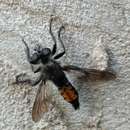Conservation Status
provided by University of Alberta Museums
Conservation is not a concern for Laphria gilva.
- license
- cc-by-nc
- copyright
- University of Alberta Museums
Cyclicity
provided by University of Alberta Museums
Adults are found late July to late August and possibly earlier and later in the southern portion of the range (Schmid 1969).
- license
- cc-by-nc
- copyright
- University of Alberta Museums
Distribution
provided by University of Alberta Museums
Laphria gilva is found holarctically; in the nearctic from the Yukon and Alaska to Quebec and Nova Scotia, and southerly from California, Colorado, and Arizona to Michigan, New York, and Massachusetts; in Eurasia from Great Britain to Siberia (Adisoemarto 1967; Cannings 1994, 1997).
- license
- cc-by-nc
- copyright
- University of Alberta Museums
General Description
provided by University of Alberta Museums
Medium to large, 15-20 mm in length. Robust flies with a general black appearance as compared to other Laphria spp. Body is mostly black, with the posterior, dorsal end of the abdomen being orange, finely pubescent (covered by hairs), and slender. Legs are black and raptorial. Laphria gilva can be distinguished by abdominal segments three, four, and five being covered dorsally with orange pubescence, and segment six being black (L. gilva can be confused with L. aimatis (McAtee), but is easily distinguished by this black sixth abdominal segment). Thoracic and leg pubescence is sparse and rather inconspicuous, and the setae of the mask and mystax (setae surrounding the pronounced hypopharynx) are uniformly black, and of medium length compared to other Laphria spp. Superior forceps of the male genitalia are each provided with two lamellar appendages (McAtee 1919; Adisoemarto 1967).
- license
- cc-by-nc
- copyright
- University of Alberta Museums
Habitat
provided by University of Alberta Museums
Open glades within boreal forests. Most often found near coniferous stands and adjacent prairies and open grasslands. Laphria gilva is the only holarctic species in Laphriinae, and is found at elevations as high as the treeline (Cannings 1994, 1997).
- license
- cc-by-nc
- copyright
- University of Alberta Museums
Life Cycle
provided by University of Alberta Museums
"Species of the genus Laphria do not exhibit courtship behaviors. Laphria gilva males establish mating areas around tree trunks and chase and grapple with females and other males that enter this area. Other males are apparently released without harm. Females, upon being charged, are knocked to the ground and mounted. The coupled pair then flies to a perch location where mating continues tail-to-tail.
Female Laphria gilva oviposit in the crevices of bark or downed wood. Larval stages live in soil and rotting wood, and their biology is poorly understood, though they are currently thought to be predacious on eggs and larvae of other insects (Hull 1962; Schmid 1969; Wood 1981)."
- license
- cc-by-nc
- copyright
- University of Alberta Museums
Trophic Strategy
provided by University of Alberta Museums
Laphria gilva
provided by wikipedia EN
- license
- cc-by-sa-3.0
- copyright
- Wikipedia authors and editors
Laphria gilva: Brief Summary
provided by wikipedia EN
Laphria gilva is a species of robber flies in the family Asilidae.
- license
- cc-by-sa-3.0
- copyright
- Wikipedia authors and editors

